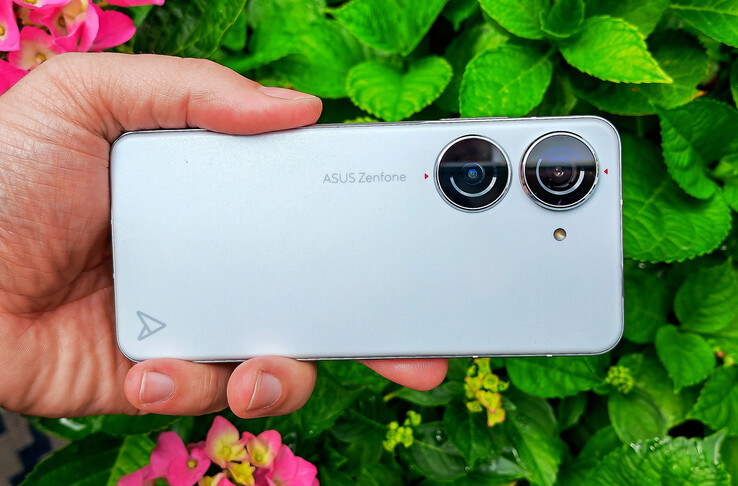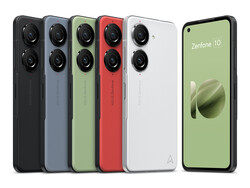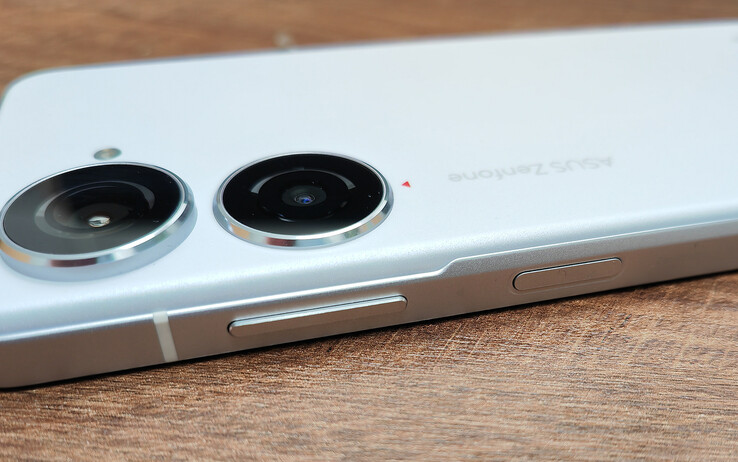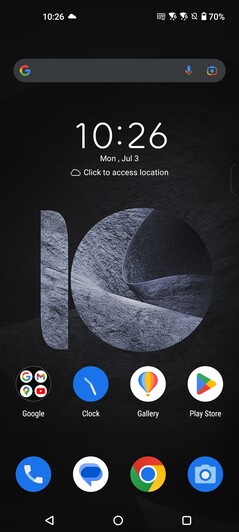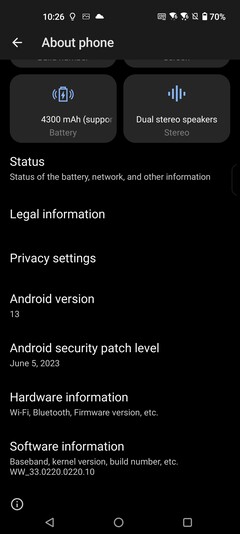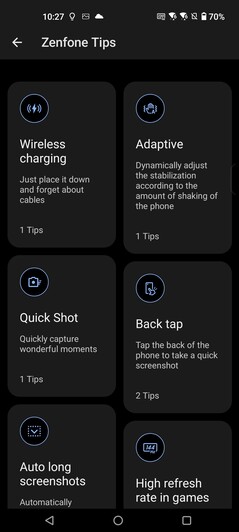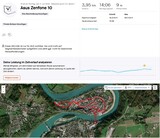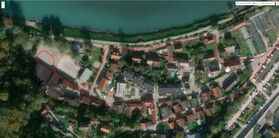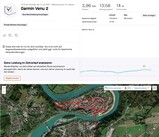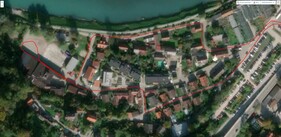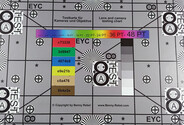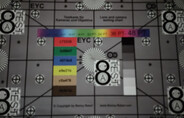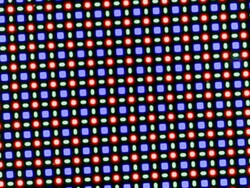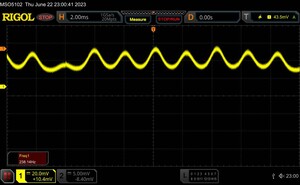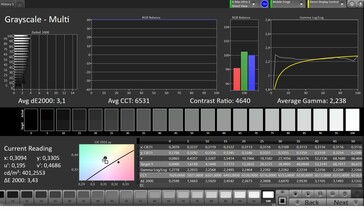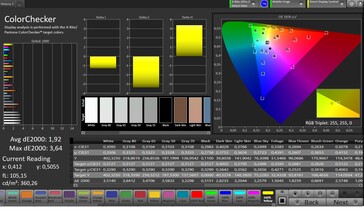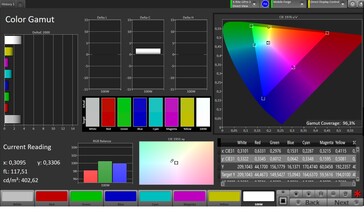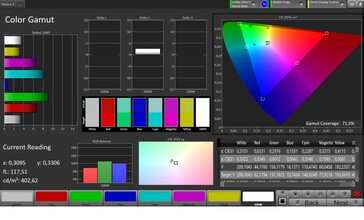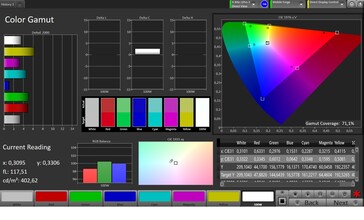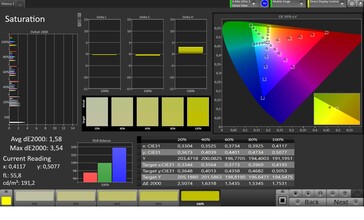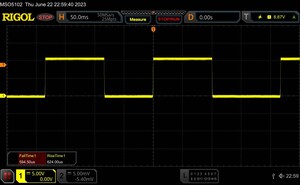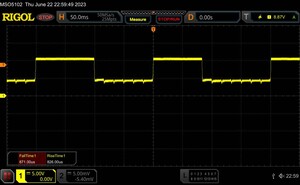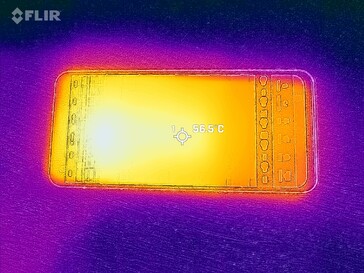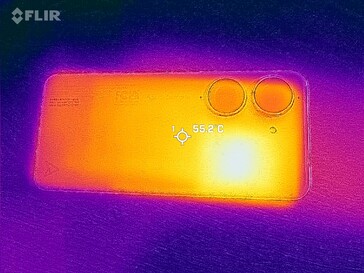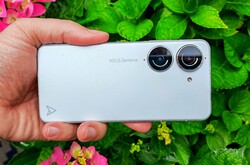Asus Zenfone 10 review: Compact 5G smartphone with a lot of power
After Apple stopped offering the latest iPhones in a hand-sized format last year, the range for people who wanted a powerful but not-so-large smartphone narrowed once again. Asus has defied the trend for a few years and continues to manufacture its Zenfones in a tidy, compact way.
The 2023 edition, the Zenfone 10, again focuses on being a high-quality smartphone with a small form factor and with as few compromises as possible. Let's find out whether this has been successful, also in view of strong competitors such as the Samsung Galaxy S23.
Possible competitors in comparison
Rating | Date | Model | Weight | Drive | Size | Resolution | Price |
|---|---|---|---|---|---|---|---|
| 88.7 % v7 (old) | 07 / 2023 | Asus Zenfone 10 SD 8 Gen 2, Adreno 740 | 172 g | 512 GB UFS 4.0 Flash | 5.90" | 2400x1080 | |
| 88.6 % v7 (old) | 09 / 2022 | Asus Zenfone 9 SD 8+ Gen 1, Adreno 730 | 169 g | 256 GB UFS 3.1 Flash | 5.90" | 2400x1080 | |
| 82.9 % v7 (old) | 09 / 2022 | Sony Xperia 10 IV SD 695 5G, Adreno 619 | 161 g | 128 GB UFS 2.1 Flash | 6.00" | 2520x1080 | |
| 89.8 % v7 (old) | 10 / 2021 | Apple iPhone 13 mini A15, A15 GPU 4-Core | 140 g | 128 GB NVMe | 5.40" | 2340x1080 | |
| 90.5 % v7 (old) | 03 / 2023 | Samsung Galaxy S23 SD 8 Gen 2 for Galaxy, Adreno 740 | 167 g | 128 GB UFS 3.1 Flash | 6.10" | 2340x1080 |
Case - Metal, Gorilla Glass and IP certification
Good thing that Asus labels its Zenfones differently on the back, otherwise you'd hardly be able to tell the difference between the last generation and the Zenfone 10 - the dimensions differ only slightly and the Zenfone 10 is 3 grams heavier. Normal users are unlikely to notice such differences.
Once again, the Zenfone is available in numerous colors. This time, light green has been added as a color option alongside red, blue, black and white. However, not every memory/storage configuration is available in every color: you have the most choice if you opt for 256 GB of storage. Some of these color variants (red, white, green) use sustainable plastic.
The screen edges on the front are quite visible, but with a screen area of 84%, which is at least still average. The screen is reinforced by Gorilla Glass Victus, so it should be well protected against breakage and damage. Additionally, IP68 certification is once again on board, so users needn't worry if the smartphone falls into water.
The solid metal frame and the roughened back make a very high-quality impression. The smartphone has a clean finish and the materials merge without any noticeable edges.
Equipment - Zenfone only with USB 2.0
The Asus Zenfone 10 comes in 3 memory/storage configurations at differing prices:
- 8 GB RAM / 128 GB: US$799
- 8 GB RAM / 256 GB: US$849
- 16 GB RAM / 512 GB: US$929
As in the predecessor, the USB-C port is only connected internally via USB 2.0, so that image transfer is not possible and the data transmission speed is also lower than in some other high-end smartphones. In return, Asus has installed a 3.5mm port, which will certainly please fans of the classic headphone jack.
NFC for wireless payment services and other uses is on board, but there is no microSD reader for expansion possibilities.
Software - Long update promise
Asus delivers the Zenfone 10 with near-stock Android 13 and hardly installs any additional software. A very positive aspect is that you can choose in the menu whether you want to adopt small adjustments from Asus or leave the Android system completely unchanged. The security patches were from June 2023 and thus still quite up to date.
According to the manufacturer, there should be 4 years of updates, plus 2 new versions of the operating system, i.e. up to Android 15.
Communication and GNSS - Support for WiFi 7
A step forward for all technology fans is the WiFi 7 support, thanks to which the 6 GHz band can be used and a wider range of transmission channels is possible.
In our tests, however, the Asus Zenfone 10 fluctuates somewhat in terms of data rates, just like the predecessor. Although these fluctuations are less compared to the Zenfone 9, the maximum data rates are not quite as high. Nevertheless, the Asus Zenfone 10 can reliably and fully utilize a gibabit internet connection.
Full signal strength is guaranteed close to the router and websites load very quickly. The signal weakens a little at a distance of 10 meters and through 3 walls, but subjectively we noticed little difference in speed.
Of course, 5G cellular is supported and there are so many 4G frequencies that mobile internet access is virtually guaranteed anywhere in the world. Reception and signal strength were very good in spot checks during our tests and on par with other high-end smartphones.
| Networking | |
| iperf3 receive AXE11000 | |
| Samsung Galaxy S23 | |
| Asus Zenfone 9 | |
| Average of class Smartphone (52 - 1721, n=177, last 2 years) | |
| Sony Xperia 10 IV | |
| iperf3 transmit AXE11000 | |
| Samsung Galaxy S23 | |
| Asus Zenfone 9 | |
| Sony Xperia 10 IV | |
| Average of class Smartphone (49.8 - 1828, n=177, last 2 years) | |
| iperf3 transmit AXE11000 6GHz | |
| Samsung Galaxy S23 | |
| Asus Zenfone 9 | |
| Asus Zenfone 10 | |
| Average of class Smartphone (508 - 1945, n=95, last 2 years) | |
| iperf3 receive AXE11000 6GHz | |
| Asus Zenfone 9 | |
| Samsung Galaxy S23 | |
| Average of class Smartphone (451 - 1870, n=95, last 2 years) | |
| Asus Zenfone 10 | |
| iperf3 transmit AX12 | |
| Apple iPhone 13 mini | |
| iperf3 receive AX12 | |
| Apple iPhone 13 mini | |
The Zenfone 10 is able to utilize all major satellite networks to determine its location. Shortly after you step outside, you are pinpointed at an accuracy of a good 3 meters. The variety of satellites found is good, but SBAS is not used to further improve accuracy.
To test the smartphone's real-world tracking capabilities, we jumped on our bikes and also took the Garmin Venu 2 smartwatch along as a comparison device. The Zenfone 10 shows minor inaccuracies, placing us slightly next to the road, for example, or having us go through houses. Overall, though, we like the accuracy. The smartphone is well suited for everyday use as a navigational device as long as absolute precision is not required.
Telephony and Voice Quality – Moderate voice quality
Asus uses its own telephony app, which strikes us as somewhat slimmed down compared to Google's standard app. But the latter can be easily installed and selected as the default. Unfortunately, the Zenfone 10 does not offer eSIM support.
We found the voice quality to be rather mediocre over the course of several test calls: clear background noise, such as rustling, can be heard over the earpiece, but the voice of our conversation partner remains intelligible. Moreover, the maximum volume of the Zenfone 10 sounds rather modest, so that understanding our calling partner in loud environments may prove problematic.
Occasionally, there is a slight echo from the other person via the loudspeaker, which almost sounds as if the noise suppression is trying to do its job. However, this leads to the fact that we understand some things that the caller says only with difficulty or not at all.
Our voice is transmitted well overall, but one shouldn't speak too quietly.
Cameras - More flexibility would be nice
The main camera has only made marginal progress compared to the predecessor: the Sony IMX766 with 50 megapixels is still used as the sensor. Only the gimbal function, which is supposed to protect the camera from strong shaking, has been revamped once again.
The Zenfone 10 takes colorful photos, but cannot keep up with real high-end smartphones in terms of detail richness. In the photo of the surroundings, the sharpness is low in detail. The main camera takes decent pictures when there is little light, but dynamics in very dark areas are lacking.
The real drawback of the Zenfone 10's camera system is the rather low level of flexibility: although the wide-angle camera takes passable pictures, it is hardly comparable to smartphones with a periscope zoom camera because it is hardly possible to get closer to objects without losing detail. This is because there is only digital zoom that offers sufficient image quality at 2x at best. After that, photos become very grainy.
8K video recording is possible, but only at 24 fps. 60 fps is available for 4K videos. The autofocus reacts promptly and reliably during recording, but the brightness adjustment is a bit rough from time to time. The resulting videos are generally of good quality.
The front camera has a resolution of 32 megapixels, whereby pixel binning for higher light output results in only 8 megapixel photos in the end. These are on a high level in good lighting and still show decent detail in darker areas.
More photos from the cameras of the Zenfone 10 and other direct comparisons with high-end smartphones can be found in our detailed camera test, for which we were out and about in Lisbon.
Image comparison
Choose a scene and navigate within the first image. One click changes the position on touchscreens. One click on the zoomed-in image opens the original in a new window. The first image shows the scaled photograph of the test device.
Main camera - flowerMain camera - environmentMain camera - low lightWide angle cameraThe main camera is also put through its paces in the test laboratory: it takes good pictures in full studio lighting, which show a high image sharpness, especially in the center, but this decreases slightly towards the edges. Colors and contrasts are displayed accurately.
At 1 lux illuminance, the subject is very blurred, but colors are still reproduced quite accurately.
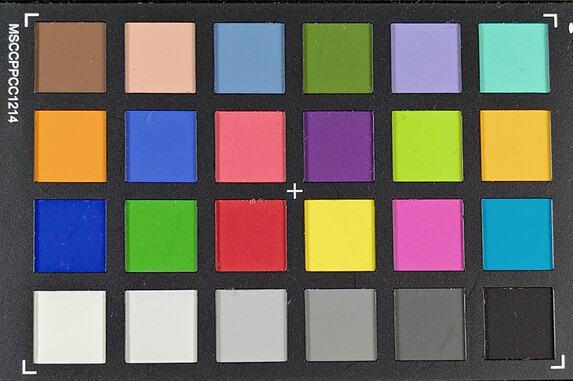
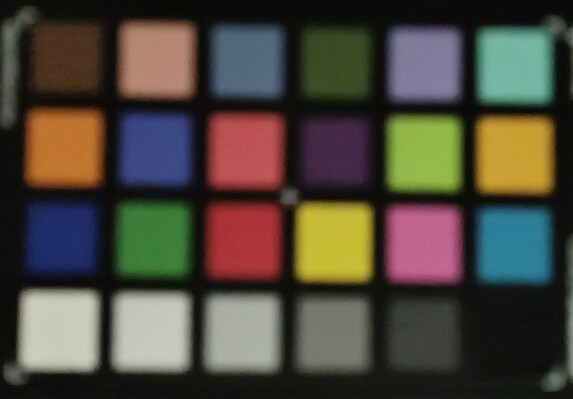
Accessories and Warranty - Protective case included
In addition to the charger, a USB cable and the SIM tool, the box for the Zenfone 10 also includes a plastic protective case that protects the smartphone from falls.
Asus' accessory store offers other matching cases, as well as an accessory set with a protective case, stand, and a pocket that can hold credit cards, for example. The whole package costs around US$50. A protective film for the screen is also available for around US$30.
Asus offers a 24-month warranty on smartphones purchased within the EU. This may differ in other regions, so buyers should double check before purchasing.
Input Devices & Operation - Compact and with a great fingerprint sensor
In matters of operation, the Zenfone 10 has several special features. On the one hand, its compact format makes it easy to use, even with smaller hands. The 144 Hz display provides a maximum of 120 Hz outside of gaming, but still makes operation feel very fluid thanks to the smooth scrolling.
The touchscreen can be operated very precisely and reliably over the entire surface. A glove mode can also be activated in the settings, which makes the screen even more sensitive and also allows it to be used with thin gloves.
The fingerprint sensor on the right side of the case unlocks the phone almost immediately and with a very good recognition rate. Gestures can also be performed on the fingerprint sensor to activate certain system functions, which Asus calls ZenTouch. There is also facial recognition as another unlocking option, but this only works with 2D images and is thus less secure.
Display - AMOLED up to 144 Hz
The AMOLED screen of the Asus Zenfone 10 offers enhanced Full HD resolution and is thus on par with the class. In terms of screen brightness, it is still well suited to brighter environments with an average of 789 cd/m², but the Samsung Galaxy S23 shows that much more is possible here.
The color representation is also not quite as accurate as in other smartphones, as some grayscale tones show a slight greenish cast. Light brown tones also deviate slightly from the optimum, but the screen is overall very suitable for everyday use and offers brilliant colors. Only if color values must be exact should you consider other better smartphones.
The screen can handle frame rates of up to 144 Hz. However, this can only be set in games; a maximum of 120 Hz is available in all other applications.
| |||||||||||||||||||||||||
Brightness Distribution: 93 %
Center on Battery: 797 cd/m²
Contrast: ∞:1 (Black: 0 cd/m²)
ΔE ColorChecker Calman: 3.64 | ∀{0.5-29.43 Ø4.77}
ΔE Greyscale Calman: 3.1 | ∀{0.09-98 Ø5}
96.3% sRGB (Calman 2D)
Gamma: 2.238
CCT: 6531 K
| Asus Zenfone 10 AMOLED, 2400x1080, 5.9" | Asus Zenfone 9 AMOLED , 2400x1080, 5.9" | Sony Xperia 10 IV OLED, 2520x1080, 6" | Apple iPhone 13 mini OLED, 2340x1080, 5.4" | Samsung Galaxy S23 Dynamic AMOLED 2x, 2340x1080, 6.1" | |
|---|---|---|---|---|---|
| Screen | 0% | 19% | 24% | -11% | |
| Brightness middle (cd/m²) | 797 | 793 -1% | 572 -28% | 851 7% | 1125 41% |
| Brightness (cd/m²) | 789 | 796 1% | 580 -26% | 847 7% | 1122 42% |
| Brightness Distribution (%) | 93 | 97 4% | 96 3% | 98 5% | 96 3% |
| Black Level * (cd/m²) | |||||
| Colorchecker dE 2000 * | 3.64 | 1.9 48% | 0.9 75% | 1 73% | 3.2 12% |
| Colorchecker dE 2000 max. * | 1.92 | 3.4 -77% | 1.2 37% | 2 -4% | 4.9 -155% |
| Greyscale dE 2000 * | 3.1 | 2.3 26% | 1.4 55% | 1.4 55% | 3.3 -6% |
| Gamma | 2.238 98% | 2.26 97% | 2.29 96% | 2.21 100% | 1.97 112% |
| CCT | 6531 100% | 6860 95% | 6614 98% | 6423 101% | 6504 100% |
* ... smaller is better
Screen Flickering / PWM (Pulse-Width Modulation)
| Screen flickering / PWM detected | 238.1 Hz | ||
The display backlight flickers at 238.1 Hz (worst case, e.g., utilizing PWM) . The frequency of 238.1 Hz is relatively low, so sensitive users will likely notice flickering and experience eyestrain at the stated brightness setting and below. In comparison: 53 % of all tested devices do not use PWM to dim the display. If PWM was detected, an average of 8081 (minimum: 5 - maximum: 343500) Hz was measured. | |||
Series of measurements at a fixed zoom level and different brightness settings
We detected PWM flickering, as is the case with almost all OLED screens. The rate is 238 Hz and the frequency fluctuates significantly, so sensitive users should definitely try out the screen before buying it. A DC dimming mode is available, but the framerate is limited to 60 Hz.
Display Response Times
| ↔ Response Time Black to White | ||
|---|---|---|
| 1.2 ms ... rise ↗ and fall ↘ combined | ↗ 0.6 ms rise | |
| ↘ 0.6 ms fall | ||
| The screen shows very fast response rates in our tests and should be very well suited for fast-paced gaming. In comparison, all tested devices range from 0.1 (minimum) to 240 (maximum) ms. » 5 % of all devices are better. This means that the measured response time is better than the average of all tested devices (20.2 ms). | ||
| ↔ Response Time 50% Grey to 80% Grey | ||
| 1.7 ms ... rise ↗ and fall ↘ combined | ↗ 0.9 ms rise | |
| ↘ 0.8 ms fall | ||
| The screen shows very fast response rates in our tests and should be very well suited for fast-paced gaming. In comparison, all tested devices range from 0.165 (minimum) to 636 (maximum) ms. » 7 % of all devices are better. This means that the measured response time is better than the average of all tested devices (31.6 ms). | ||
The smartphone is bright enough outdoors, even on sunny days. Screen content is still easily visible when viewed from the side.
Performance - More is hardly possible at the moment
Thanks to the Qualcomm Snapdragon 8 Gen 2, the Zenfone 10 is on par with current flagship smartphones in terms of performance. You can choose in the menu whether the phone should provide maximum power or rather be optimized for battery life.
In any case, the Zenfone 10 does not reveal any weaknesses in the benchmarks, regardless of whether they are processor-, system- or AI tests. In everyday life, you don't have to worry that the smartphone may not have enough power for an app or that you might have problems with multitasking. For example, you can easily watch a streaming video in a floating window while surfing the web or using other apps.
| UL Procyon AI Inference for Android - Overall Score NNAPI | |
| Asus Zenfone 9 | |
| Average of class Smartphone (3769 - 81594, n=132, last 2 years) | |
| Samsung Galaxy S23 | |
| Asus Zenfone 10 | |
| Average Qualcomm Snapdragon 8 Gen 2 (11338 - 16880, n=21) | |
| Sony Xperia 10 IV | |
| AImark - Score v3.x | |
| Average Qualcomm Snapdragon 8 Gen 2 (941 - 173234, n=18) | |
| Average of class Smartphone (82 - 307528, n=119, last 2 years) | |
| Asus Zenfone 10 | |
| Samsung Galaxy S23 | |
The graphics power is also very strong. Benchmarks in 1440p resolution, for example, run at over 60 fps, while the maximum frame rate of the screen is even exceeded at 1080p. Only in 4K resolution do you have to settle for 29 fps.
However, since such high resolutions cannot be selected in most mobile games anyway, the graphics power should easily suffice for current applications. The Zenfone 10 should also be quite futureproof.
GFXBench (DX / GLBenchmark) 2.7: T-Rex Onscreen | 1920x1080 T-Rex Offscreen
GFXBench 3.0: on screen Manhattan Onscreen OGL | 1920x1080 1080p Manhattan Offscreen
GFXBench 3.1: on screen Manhattan ES 3.1 Onscreen | 1920x1080 Manhattan ES 3.1 Offscreen
GFXBench: on screen Car Chase Onscreen | 1920x1080 Car Chase Offscreen | on screen Aztec Ruins High Tier Onscreen | 2560x1440 Aztec Ruins High Tier Offscreen | on screen Aztec Ruins Normal Tier Onscreen | 1920x1080 Aztec Ruins Normal Tier Offscreen | 3840x2160 4K Aztec Ruins High Tier Offscreen
| 3DMark / Wild Life Extreme Unlimited | |
| Asus Zenfone 10 | |
| Samsung Galaxy S23 | |
| Asus Zenfone 9 | |
| Apple iPhone 13 mini | |
| Sony Xperia 10 IV | |
| 3DMark / Wild Life Extreme | |
| Samsung Galaxy S23 | |
| Asus Zenfone 10 | |
| Asus Zenfone 9 | |
| Apple iPhone 13 mini | |
| Sony Xperia 10 IV | |
| GFXBench (DX / GLBenchmark) 2.7 / T-Rex Onscreen | |
| Asus Zenfone 9 | |
| Samsung Galaxy S23 | |
| Asus Zenfone 10 | |
| Apple iPhone 13 mini | |
| Sony Xperia 10 IV | |
| GFXBench (DX / GLBenchmark) 2.7 / T-Rex Offscreen | |
| Asus Zenfone 10 | |
| Samsung Galaxy S23 | |
| Asus Zenfone 9 | |
| Apple iPhone 13 mini | |
| Sony Xperia 10 IV | |
| GFXBench 3.0 / Manhattan Onscreen OGL | |
| Samsung Galaxy S23 | |
| Asus Zenfone 10 | |
| Asus Zenfone 9 | |
| Apple iPhone 13 mini | |
| Sony Xperia 10 IV | |
| GFXBench 3.0 / 1080p Manhattan Offscreen | |
| Asus Zenfone 10 | |
| Samsung Galaxy S23 | |
| Asus Zenfone 9 | |
| Apple iPhone 13 mini | |
| Sony Xperia 10 IV | |
| GFXBench 3.1 / Manhattan ES 3.1 Onscreen | |
| Samsung Galaxy S23 | |
| Asus Zenfone 10 | |
| Asus Zenfone 9 | |
| Apple iPhone 13 mini | |
| Sony Xperia 10 IV | |
| GFXBench 3.1 / Manhattan ES 3.1 Offscreen | |
| Asus Zenfone 10 | |
| Samsung Galaxy S23 | |
| Apple iPhone 13 mini | |
| Asus Zenfone 9 | |
| Sony Xperia 10 IV | |
| GFXBench / Car Chase Onscreen | |
| Asus Zenfone 10 | |
| Samsung Galaxy S23 | |
| Asus Zenfone 9 | |
| Apple iPhone 13 mini | |
| Sony Xperia 10 IV | |
| GFXBench / Car Chase Offscreen | |
| Asus Zenfone 10 | |
| Samsung Galaxy S23 | |
| Asus Zenfone 9 | |
| Apple iPhone 13 mini | |
| Sony Xperia 10 IV | |
| GFXBench / Aztec Ruins High Tier Onscreen | |
| Samsung Galaxy S23 | |
| Asus Zenfone 10 | |
| Asus Zenfone 9 | |
| Apple iPhone 13 mini | |
| Sony Xperia 10 IV | |
| GFXBench / Aztec Ruins High Tier Offscreen | |
| Samsung Galaxy S23 | |
| Asus Zenfone 10 | |
| Asus Zenfone 9 | |
| Apple iPhone 13 mini | |
| Sony Xperia 10 IV | |
| GFXBench / Aztec Ruins Normal Tier Onscreen | |
| Samsung Galaxy S23 | |
| Asus Zenfone 10 | |
| Asus Zenfone 9 | |
| Apple iPhone 13 mini | |
| Sony Xperia 10 IV | |
| GFXBench / Aztec Ruins Normal Tier Offscreen | |
| Asus Zenfone 10 | |
| Samsung Galaxy S23 | |
| Asus Zenfone 9 | |
| Apple iPhone 13 mini | |
| Sony Xperia 10 IV | |
| GFXBench / 4K Aztec Ruins High Tier Offscreen | |
| Samsung Galaxy S23 | |
| Asus Zenfone 10 | |
| Asus Zenfone 9 | |
| Sony Xperia 10 IV | |
The Zenfone 10 is often a little slower than other compact high-end smartphones in web browsing. Nevertheless, large websites are loaded quickly and pictures are usually already visible when scrolling. Indeed, it could be a little faster in everyday use, but this is splitting hairs.
| Jetstream 2 - 2.0 Total Score | |
| Apple iPhone 13 mini (Safari 15) | |
| Samsung Galaxy S23 (Chrome 109) | |
| Average of class Smartphone (23.8 - 387, n=147, last 2 years) | |
| Asus Zenfone 9 (Chrome 104) | |
| Asus Zenfone 10 (Chrome 114) | |
| Average Qualcomm Snapdragon 8 Gen 2 (62.7 - 179.2, n=23) | |
| Sony Xperia 10 IV (Chrome 103.0.5060.129) | |
| Speedometer 2.0 - Result 2.0 | |
| Apple iPhone 13 mini (Safari 15) | |
| Average of class Smartphone (15.2 - 643, n=119, last 2 years) | |
| Average Qualcomm Snapdragon 8 Gen 2 (62.9 - 225, n=18) | |
| Samsung Galaxy S23 (Chrome 109) | |
| Asus Zenfone 10 (Chome 114) | |
| Asus Zenfone 9 | |
| Sony Xperia 10 IV (Chrome 103.0.5060.129) | |
| WebXPRT 4 - Overall | |
| Apple iPhone 13 mini (Safari 16) | |
| Average of class Smartphone (27 - 306, n=143, last 2 years) | |
| Asus Zenfone 9 (Chrome 104) | |
| Samsung Galaxy S23 (Chrome 109) | |
| Asus Zenfone 10 (Chrome 114) | |
| Average Qualcomm Snapdragon 8 Gen 2 (28 - 183, n=22) | |
| Sony Xperia 10 IV (Chrome 103.0.5060.129) | |
| WebXPRT 3 - Overall | |
| Apple iPhone 13 mini (Safari 15) | |
| Asus Zenfone 10 (Chrome 114) | |
| Average Qualcomm Snapdragon 8 Gen 2 (115 - 238, n=11) | |
| Average of class Smartphone (38 - 380, n=30, last 2 years) | |
| Asus Zenfone 9 (Chrome 104) | |
| Sony Xperia 10 IV (Chrome 103.0.5060.129) | |
| Octane V2 - Total Score | |
| Apple iPhone 13 mini (Safari 15) | |
| Samsung Galaxy S23 (Chrome 109) | |
| Asus Zenfone 9 (Chrome 104) | |
| Average of class Smartphone (2228 - 126661, n=194, last 2 years) | |
| Average Qualcomm Snapdragon 8 Gen 2 (19870 - 65418, n=25) | |
| Asus Zenfone 10 (Chrome 114) | |
| Sony Xperia 10 IV (Chrome 103.0.5060.129) | |
| Mozilla Kraken 1.1 - Total | |
| Sony Xperia 10 IV (Chrome 103.0.5060.129) | |
| Average of class Smartphone (257 - 28190, n=154, last 2 years) | |
| Average Qualcomm Snapdragon 8 Gen 2 (602 - 1837, n=22) | |
| Asus Zenfone 10 (Chrome 114) | |
| Asus Zenfone 9 (Chrome 104) | |
| Samsung Galaxy S23 (Chrome 109) | |
| Apple iPhone 13 mini | |
* ... smaller is better
The UFS 4.0 storage is a plus for the Zenfone 10, as it manages to transfer data much faster than the Zenfone 9 with its UFS 3.1 flash. This means that copying processes can be carried out very quickly and loading times are shorter.
However, it is annoying that the Zenfone 10 still only has a USB 2.0 port, which often proves to be a bottleneck when transferring data to or from external devices.
| Asus Zenfone 10 | Asus Zenfone 9 | Sony Xperia 10 IV | Samsung Galaxy S23 | Average 512 GB UFS 4.0 Flash | Average of class Smartphone | |
|---|---|---|---|---|---|---|
| AndroBench 3-5 | -36% | -73% | -47% | -4% | -36% | |
| Sequential Read 256KB (MB/s) | 3517.3 | 1986.97 -44% | 521.1 -85% | 3133.7 ? -11% 1686.71 ? -52% | 3689 ? 5% | 2235 ? -36% |
| Sequential Write 256KB (MB/s) | 3041.5 | 1776.21 -42% | 497.61 -84% | 844 ? -72% 628.53 ? -79% | 3092 ? 2% | 1871 ? -38% |
| Random Read 4KB (MB/s) | 418.1 | 298.46 -29% | 192.5 -54% | 427.61 ? 2% 343.65 ? -18% | 385 ? -8% | 297 ? -29% |
| Random Write 4KB (MB/s) | 559.4 | 398.39 -29% | 177.83 -68% | 156.69 ? -72% 130.26 ? -77% | 474 ? -15% | 343 ? -39% |
Gaming - Futureproof
The Zenfone 10's screen is well suited for smooth gaming with a maximum of 144 Hz, but there are hardly any games that allow for such high frame rates. At least the smartphone reaches a steady 60 fps in RPG Diablo: Immortal, and this is also possible at almost all settings in PUBG Mobile. The frame rate only drops to 40 fps in UltraHD. Frame rates were tested with software from GameBench.
The Zenfone 10 is completely sufficient for current games, but our test device can get very warm during gaming.
Emissions - Hot case, but hardly any performance losses
Temperature
In contrast to its predecessor, the Zenfone 10 heats up a lot under prolonged load, gets really hot and is then no longer comfortable to hold. Our test is an extreme scenario, but these levels can definitely be reached during long, demanding gaming sessions and in warm ambient temperatures.
Fortunately, the smartphone doesn't crash and the processor remains relatively unaffected by the high case temperatures in the 3DMark stress tests. Instead of throttling heavily and keeping the temperature low, the temperatures remain high, but so does performance.
If you want to limit the heat and can afford to sacrifice a little performance, you'll find various settings in the menu under "System modes", which can reduce the power a little and thus extend the battery life.
(-) The maximum temperature on the upper side is 55.8 °C / 132 F, compared to the average of 35.2 °C / 95 F, ranging from 21.9 to 247 °C for the class Smartphone.
(-) The bottom heats up to a maximum of 57.9 °C / 136 F, compared to the average of 34 °C / 93 F
(+) In idle usage, the average temperature for the upper side is 27.5 °C / 82 F, compared to the device average of 32.9 °C / 91 F.
3DMark Wild Life Stress Test
| 3DMark | |
| Wild Life Stress Test Stability | |
| Asus Zenfone 10 | |
| Sony Xperia 10 IV | |
| Samsung Galaxy S23 | |
| Apple iPhone 13 mini | |
| Asus Zenfone 9 | |
| Wild Life Extreme Stress Test | |
| Sony Xperia 10 IV | |
| Asus Zenfone 10 | |
| Apple iPhone 13 mini | |
| Samsung Galaxy S23 | |
| Asus Zenfone 9 | |
Speakers
The Zenfone 10 comes with hybrid stereo speakers, which means the earpiece above the screen is used as a second speaker. This allows for slight stereo effects if you place the smartphone correctly, and of course, a second speaker also makes the sound fuller overall.
At 83.2 dB(A), the speakers are sufficiently loud when needed. They cope well with different styles of music and do not overdrive, even at maximum volume. However, they always sound a bit treble-heavy and only offer little in the way of mids or bass.
Those who likes to connect their analogue headphones will get a 3.5 mm audio port on the Zenfone 10, a rarity on expensive smartphones. The sound is just as clean as when connected via Bluetooth 5.3, whereby numerous codecs are available here: in addition to SBC and AAC, there is also aptX, aptX HD, aptX Adaptive, aptX TWS+, LDAC and LC3. Hence, plenty of high-quality wireless codecs that can transmit HD audio.
Asus Zenfone 10 audio analysis
(+) | speakers can play relatively loud (83.2 dB)
Bass 100 - 315 Hz
(-) | nearly no bass - on average 19.5% lower than median
(±) | linearity of bass is average (8.5% delta to prev. frequency)
Mids 400 - 2000 Hz
(±) | higher mids - on average 5.7% higher than median
(+) | mids are linear (6.1% delta to prev. frequency)
Highs 2 - 16 kHz
(±) | higher highs - on average 5.8% higher than median
(+) | highs are linear (6.2% delta to prev. frequency)
Overall 100 - 16.000 Hz
(±) | linearity of overall sound is average (20.2% difference to median)
Compared to same class
» 33% of all tested devices in this class were better, 9% similar, 58% worse
» The best had a delta of 11%, average was 35%, worst was 134%
Compared to all devices tested
» 52% of all tested devices were better, 8% similar, 40% worse
» The best had a delta of 4%, average was 24%, worst was 134%
Samsung Galaxy S23 audio analysis
(+) | speakers can play relatively loud (91.5 dB)
Bass 100 - 315 Hz
(-) | nearly no bass - on average 22.5% lower than median
(+) | bass is linear (6.1% delta to prev. frequency)
Mids 400 - 2000 Hz
(±) | reduced mids - on average 5.8% lower than median
(+) | mids are linear (3.9% delta to prev. frequency)
Highs 2 - 16 kHz
(+) | balanced highs - only 4.5% away from median
(+) | highs are linear (1.8% delta to prev. frequency)
Overall 100 - 16.000 Hz
(±) | linearity of overall sound is average (16.2% difference to median)
Compared to same class
» 6% of all tested devices in this class were better, 5% similar, 90% worse
» The best had a delta of 11%, average was 35%, worst was 134%
Compared to all devices tested
» 25% of all tested devices were better, 5% similar, 69% worse
» The best had a delta of 4%, average was 24%, worst was 134%
Battery Life - Suitable for everyday use, but not outstanding
Power Consumption
The fact that the processor doesn't throttle its performance is also noticeable in the energy consumption. While quite high under load, it is at a normal level under low load.
Like its predecessor, the smartphone can be charged with up to 30 watts. When the battery is completely empty, it takes around 90 minutes until the display shows 100% again. A major innovation is that the Zenfone 10 now also supports wireless charging up to 15 watts.
| Off / Standby | |
| Idle | |
| Load |
|
Key:
min: | |
| Asus Zenfone 10 4300 mAh | Asus Zenfone 9 4300 mAh | Sony Xperia 10 IV 5000 mAh | Apple iPhone 13 mini 2406 mAh | Samsung Galaxy S23 3900 mAh | Average Qualcomm Snapdragon 8 Gen 2 | Average of class Smartphone | |
|---|---|---|---|---|---|---|---|
| Power Consumption | 19% | 16% | 30% | 41% | -19% | -6% | |
| Idle Minimum * (Watt) | 0.9 | 1.01 -12% | 0.68 24% | 0.57 37% | 0.57 37% | 1.036 ? -15% | 0.847 ? 6% |
| Idle Average * (Watt) | 1.1 | 1.1 -0% | 1.69 -54% | 1.38 -25% | 0.74 33% | 1.766 ? -61% | 1.446 ? -31% |
| Idle Maximum * (Watt) | 1.5 | 1.17 22% | 1.73 -15% | 1.41 6% | 0.83 45% | 1.94 ? -29% | 1.63 ? -9% |
| Load Average * (Watt) | 7.6 | 3.3 57% | 2.54 67% | 2.65 65% | 4.26 44% | 7.22 ? 5% | 6.95 ? 9% |
| Load Maximum * (Watt) | 11 | 7.89 28% | 4.61 58% | 3.56 68% | 6.16 44% | 10.4 ? 5% | 11.3 ? -3% |
* ... smaller is better
Power consumption: Geekbench (150 cd/m²)
Power consumption: GFXBench (150 cd/m²)
Battery Life
At 4,300 mAh, the battery has the same capacity as the Zenfone 9 and is thus much stronger than, for example, the iPhone 13 mini or the Samsung Galaxy S23.
However, that does not automatically mean better runtimes, as tests show. The Asus Zenfone proves to be a little more enduring under load and when watching videos from storage, but our test device is only at an average level with around 14 hours of WLAN browsing.
Nevertheless, you should get through a working day and even those who work overtime should still have some power left in reserve. But if you use your smartphone regularly, you won't be able to avoid recharging every evening.
| Asus Zenfone 10 4300 mAh | Asus Zenfone 9 4300 mAh | Sony Xperia 10 IV 5000 mAh | Apple iPhone 13 mini 2406 mAh | Samsung Galaxy S23 3900 mAh | |
|---|---|---|---|---|---|
| Battery runtime | 2% | 41% | 5% | 4% | |
| Reader / Idle (h) | 31.1 | 28.1 -10% | 62.7 102% | 51.8 67% | 37.5 21% |
| H.264 (h) | 22.5 | 23.4 4% | 26.3 17% | 17.4 -23% | 20.9 -7% |
| WiFi v1.3 (h) | 14 | 13.8 -1% | 19.5 39% | 14.2 1% | 15.4 10% |
| Load (h) | 6.8 | 7.7 13% | 7.2 6% | 5 -26% | 6.2 -9% |
Pros
Cons
Verdict - Extreme power in a compact format
Asus' Zenfone 10 will please everyone who finds the current flagship cellphones too bulky: the compact and relatively light smartphone comes with a lot of memory on request, which also works as fast as an arrow. It scores with very high system performance, long software updates, fast WiFi 7 and a stylish, IP-certified case that is also available in brighter color variants.
At a price of US$749, however, the smartphone competes with the Samsung Galaxy S23 or the Apple iPhone 13 mini and you have to accept a few weaknesses. For example, compared to Samsung's flagship, the camera lacks the optical zoom capability, which reduces the flexibility of the camera setup. Compared to the iPhone, the images appear less sharp.
The screen could also be a little brighter, the strong heating of the phone under high load is annoying and the battery life is average. The fact that Asus installs a USB 2.0 port in its Zenfone 10 is also no reason for joy. But users who want a 3.5mm port combined with high performance will hardly get past the Zenfone 10.
Compared to the Zenfone 9 predecessor, the changes are few, but the faster storage and wireless charging stand out.
The Zenfone 10 is a tentative update of the previous generation that convinces thanks to its compact dimensions and high performance.
Since the prices for the Samsung Galaxy S23 have fallen significantly in the meantime, it is a strong competitor thanks to its zoom camera and even brighter screen. The Zenfone 9 is also cheaper and buyers only have to settle for minor drawbacks, such as the slightly slower storage.
Price and Availability
The Asus Zenfone 10 is currently available for purchase via Amazon US in the 8GB/256GB configuration for US$799.00. This can be purchased in Blue, White or Black. Other memory configurations are expected to follow in the coming weeks as the smartphone is gradually rolled out.
Prices are as of 13.07.2023 and are subject to change.
Asus Zenfone 10
- 07/12/2023 v7 (old)
Florian Schmitt
Transparency
The selection of devices to be reviewed is made by our editorial team. The test sample was provided to the author as a loan by the manufacturer or retailer for the purpose of this review. The lender had no influence on this review, nor did the manufacturer receive a copy of this review before publication. There was no obligation to publish this review. As an independent media company, Notebookcheck is not subjected to the authority of manufacturers, retailers or publishers.
This is how Notebookcheck is testing
Every year, Notebookcheck independently reviews hundreds of laptops and smartphones using standardized procedures to ensure that all results are comparable. We have continuously developed our test methods for around 20 years and set industry standards in the process. In our test labs, high-quality measuring equipment is utilized by experienced technicians and editors. These tests involve a multi-stage validation process. Our complex rating system is based on hundreds of well-founded measurements and benchmarks, which maintains objectivity. Further information on our test methods can be found here.


